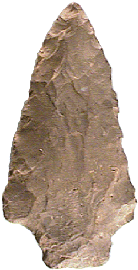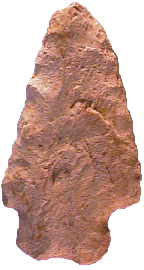



Point Type:
SNOOK KILL
Also See: Atlantic Phase, Dewart Stemmed, Koens-Crispin, Ledbetter, Lehigh,
Little Bear Creek ,
Merrimack
, Mulberry
Creek, Pickwick, Sandhill Stemmed,
Savannah
River, Stark,
Taconic Stemmed
Location: Northeastern United States
Associated Dates:
3900 - 3420 B.P.- Late
Archaic
Morphology: Stemmed
General
Description: The
Snook Kill point is a medium to large sized triangular bladed,
stemmed Late Archaic dart or spear point. The blade's outline
is typically triangular with either convex, straight or concave
edges. The shoulders are
well defined. The shoulders are typically at right angles or are
slightly sloping away from the stem and are often asymmetric. There
are a few specimens with a hint of a slightly barbed shoulder.
The stem is straight or slightly contracting to
a base which is most often straight but is occasionally rounded.
The Snook Kill type is usually found in eastern
New York and Connecticut and is occasionally found in northeastern
Pennsylvania, Massachusetts, New Jersey and Delaware. The typical
lithic material used in the manufacture of the Snook Kill
were New York flints such as Coxsackie, Deepkill, Fort Ann, Onondaga
and Oriskany. Some examples have been made from argillite, quartz
and quartzite.
The Snook
Kill ranges in size from 50 mm to 102 mm in length.
The Snook Kill point was named by
William A. Ritchie for examples he found at the Snook Kill site,
Saratoga County, New York. Ritchie hypothesized that the variant
of this point with asymmetric blade edges and an almost lozenge
shaped base were knives.
About the Point Above (Left): The point pictured above on the left of the page is an average sized Snook Kill point made from a grayish and greenish dull flint or chert material. The point measures 61 mm in length, 30 mm at the widest point (across the shoulders) and is 8 mm thick at mid blade just above the shoulders. The stem is 19 mm wide where it joints the blade and contracts down to 15 mm. The base straight and is ground. The base is thinned to 5.5 mm in thickness. The base was thinned by the removal of two thinning flakes from each face. This point was found near the town of Harrisonville, Salem County, New Jersey. Catalog Number 318-14-C
About the Point Above (Right): The point pictured above on the right of the page is an average sized Snook Kill concave base point made from a light tan colored dull, porous, chert material. The point measures 59 mm in length, 30 mm at the widest point (across the shoulders) and is 8.5 mm thick at mid blade just above the shoulders. The stem is 20 mm wide where it joints the blade and expands to 21 mm. The base slightly bifurcated or concave and is ground. The base is thinned to 5 mm in thickness. The base was thinned by the removal of one thinning flake which produced the bifurcation. This point is highly patinated and has one fire pock mark. Needless to say, it is well worn and the tip is chipped off. This point was a surface find from the corn fields of the historic Robert Treat Farm, in the borough of Woodmont, town of Milford, New Haven County, Connecticut. Catalog Number317-10-C
References: Dragoo (e, f), Fogleman, Ritchie
© Copyright 1997 - 2009 LITHICS-Net WWW.LITHICSNET.COM
Use Your Browser's BACK Button to Return to the LITHICS-Net Index.